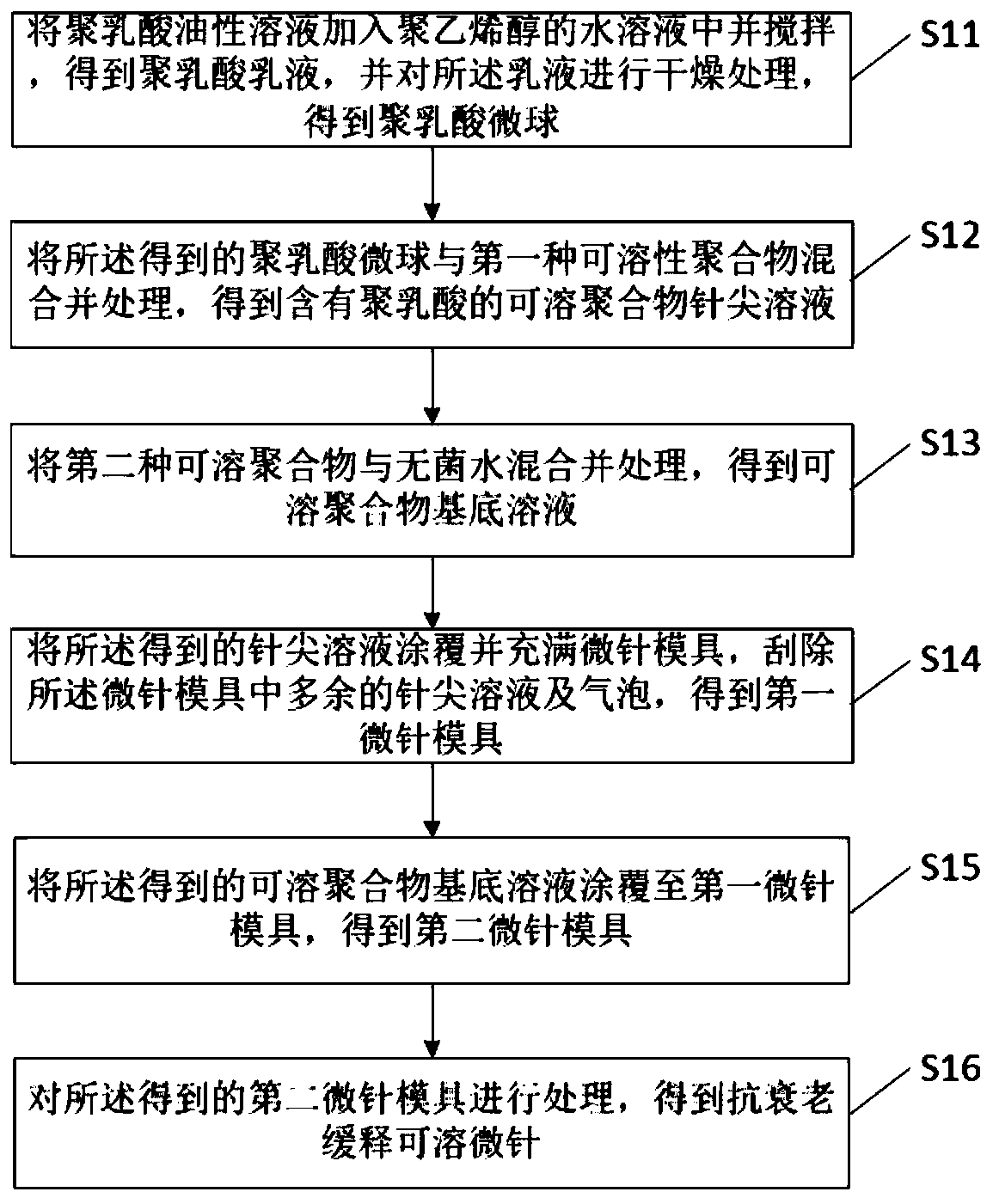Anti-aging slow-release soluble microneedle based on polylactic acid compound and preparation method of microneedle
A technology of polylactic acid microspheres and polylactic acid, which is applied in chemical instruments and methods, microneedles, medical instruments, etc., can solve the problems of short duration of effect and inability to maintain the effect for a long time.
- Summary
- Abstract
- Description
- Claims
- Application Information
AI Technical Summary
Problems solved by technology
Method used
Image
Examples
Embodiment 1
[0052] This example provides a preparation method for anti-aging slow-release soluble microneedles based on polylactic acid compounds, such as figure 1 shown, including:
[0053] S11. adding the polylactic acid oily solution into an aqueous solution of polyvinyl alcohol and stirring to obtain a polylactic acid emulsion, and drying the emulsion to obtain polylactic acid microspheres;
[0054] S12. Mixing and treating the obtained polylactic acid microspheres with the first soluble polymer to obtain a soluble polymer needle tip solution containing polylactic acid;
[0055] S13. Mixing and treating the second soluble polymer with sterile water to obtain a soluble polymer base solution;
[0056] S14. Coating and filling the microneedle mold with the obtained needle tip solution, scraping off the excess needle tip solution and air bubbles in the microneedle mold to obtain a first microneedle mold;
[0057] S15. Coating the obtained soluble polymer base solution to the first micro...
Embodiment 2
[0112] The difference between the preparation method of anti-aging slow-release soluble microneedles based on polylactic acid compounds provided in this example and Example 1 is that:
[0113] This embodiment is described by specific proportioning:
[0114] S11. dissolving L-polylactic acid in methylene chloride at a mass ratio of 1:19 to make a solution;
[0115] S12. At 15°C, slowly add the L-polylactic acid solution into the aqueous solution containing 0.5% polyvinyl alcohol while stirring, stir at a high speed for a period of time, and the stirring speed is 1200r / min;
[0116] S13. heating to 40° C. to evaporate the solvent;
[0117] S14. After the solvent is evaporated, centrifuge, wash, and place in a vacuum environment with a vacuum degree of -0.06Mpa to dry for 24 hours at room temperature to obtain L-polylactic acid microspheres;
[0118] S15. dissolving the polylactic acid microspheres in sterile water at a mass ratio of 1:5 to obtain a polylactic acid solution;
...
Embodiment 3
[0132] The difference between the preparation method of anti-aging slow-release soluble microneedles based on polylactic acid compounds provided in this example and Example 1 is that:
[0133] This embodiment is described by specific proportioning:
[0134] S11. Polyglycolide is dissolved in methylene chloride at a mass ratio of 1:19 to form a solution;
[0135] S12. At 15°C, slowly add the polyglycolide solution into the aqueous solution containing 1% polyvinyl alcohol while stirring, stir at high speed for a period of time, and the stirring speed is 1000r / min;
[0136] S13. heating to 40° C. to evaporate the solvent;
[0137] S14. After the solvent is evaporated, centrifuge, wash, and place at room temperature in a vacuum environment with a vacuum degree of -0.06Mpa to dry for 24 hours to obtain polyglycolide microspheres;
[0138] S15. Dissolving the polyglycolide microspheres in sterile water at a mass ratio of 1:10 to obtain a polyglycolide solution;
[0139] S16. Weig...
PUM
| Property | Measurement | Unit |
|---|---|---|
| thickness | aaaaa | aaaaa |
| thickness | aaaaa | aaaaa |
Abstract
Description
Claims
Application Information
 Login to View More
Login to View More - R&D
- Intellectual Property
- Life Sciences
- Materials
- Tech Scout
- Unparalleled Data Quality
- Higher Quality Content
- 60% Fewer Hallucinations
Browse by: Latest US Patents, China's latest patents, Technical Efficacy Thesaurus, Application Domain, Technology Topic, Popular Technical Reports.
© 2025 PatSnap. All rights reserved.Legal|Privacy policy|Modern Slavery Act Transparency Statement|Sitemap|About US| Contact US: help@patsnap.com



